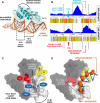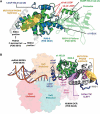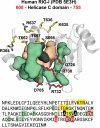Dissecting protein domain variability in the core RNA interference machinery of five insect orders
- PMID: 33302789
- PMCID: PMC8582983
- DOI: 10.1080/15476286.2020.1861816
Dissecting protein domain variability in the core RNA interference machinery of five insect orders
Abstract
RNA interference (RNAi)-mediated gene silencing can be used to control specific insect pest populations. Unfortunately, the variable efficiency in the knockdown levels of target genes has narrowed the applicability of this technology to a few species. Here, we examine the current state of knowledge regarding the miRNA (micro RNA) and siRNA (small interfering RNA) pathways in insects and investigate the structural variability at key protein domains of the RNAi machinery. Our goal was to correlate domain variability with mechanisms affecting the gene silencing efficiency. To this end, the protein domains of 168 insect species, encompassing the orders Coleoptera, Diptera, Hemiptera, Hymenoptera, and Lepidoptera, were analysed using our pipeline, which takes advantage of meticulous structure-based sequence alignments. We used phylogenetic inference and the evolutionary rate coefficient (K) to outline the variability across domain regions and surfaces. Our results show that four domains, namely dsrm, Helicase, PAZ and Ribonuclease III, are the main contributors of protein variability in the RNAi machinery across different insect orders. We discuss the potential roles of these domains in regulating RNAi-mediated gene silencing and the role of loop regions in fine-tuning RNAi efficiency. Additionally, we identified several order-specific singularities which indicate that lepidopterans have evolved differently from other insect orders, possibly due to constant coevolution with plants and viruses. In conclusion, our results highlight several variability hotspots that deserve further investigation in order to improve the application of RNAi technology in the control of insect pests.
Keywords: In silico analysis; argonaute; dicer; drosha; dsRBDs; loquacious; pasha; protein evolution; r2d2; structure-function relationship.
Conflict of interest statement
No potential conflict of interest was reported by the authors.
Figures












References
-
- Fire A, Xu S, Montgomery MK, et al. Potent and specific genetic interference by double-stranded RNA in Caenorhabditis elegans. Nature. 1998. Feb;391(6669):806–811. - PubMed
-
- Olsen PH, The AV.. lin-4 regulatory RNA controls developmental timing in Caenorhabditis elegans by blocking LIN-14 protein synthesis after the initiation of translation. Dev Biol. 1999. Dec;216(2):671–680. - PubMed
-
- Kavi HH, Fernandez H, Xie W, et al. Genetics and biochemistry of RNAi in Drosophila. Curr Top Microbiol Immunol. 2008;320:37–75. - PubMed
-
- Li H, Li WX, Ding SW. Induction and suppression of RNA silencing by an animal virus. Science. 2002. May;296(5571):1319–1321. - PubMed
Publication types
MeSH terms
Substances
LinkOut - more resources
Full Text Sources
Other Literature Sources
